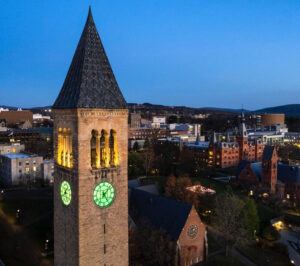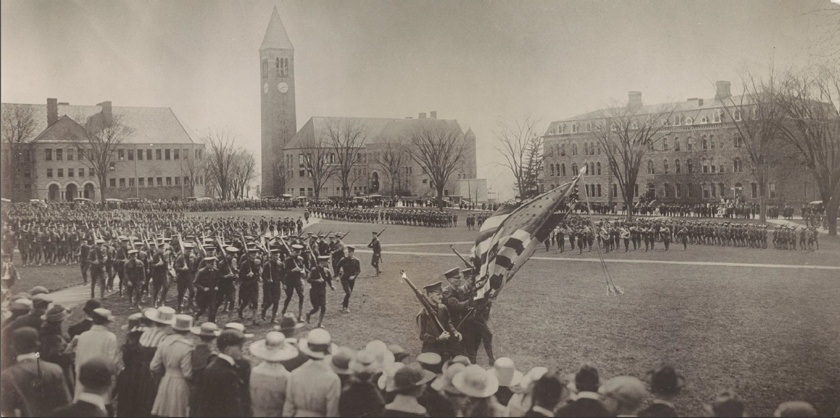When Seamus Murphy ’17 arrived at Cornell in the fall 2013, he was one of just over a dozen student veterans. Veterans comprise about 5% of the national student population, but when Seamus entered Cornell, they represented less than .01% of the student body.
In 2013, there was no residential space for veterans on campus, no staff person assigned to support veterans, no organization to connect these students, and no alumni veterans network to provide mentorship.
Seamus decided to do something about this. For the next four years, he spent about 10 hours a week advocating on behalf of himself and his fellow veterans.
“We started to look for proportional representation,” he says. He and another student veteran, David Outlaw ’17, began comparing notes. They talked to their peers and realized that their GI Bill benefits were sometimes delayed—“to the point where it was causing an undue burden on the student veterans,” Seamus explains.
Greenlight a Vet

Seamus and David began corresponding with administrators in Student and Campus Life to ask for more services and support. Early on, they asked the administration to light the clock face on McGraw Tower green on Veteran’s Day—a small but powerful way to honor Cornell veterans.
When their request was declined, Seamus headed to the university archives in Olin Library, where he learned that military service was a longstanding tradition at Cornell. From old yearbook photos, he saw that in the early days of Cornell, male students were asked to march in formation up the hill to campus on the first day of classes.
He and David kept advocating to light the clock tower green. David penned an op-ed for The Cornell Daily Sun, which raised awareness for their campaign. On Veteran’s Day 2016 their request was approved—starting a new ‘Greenlight a Vet’ tradition at Cornell.
Cornell Military Network
Seamus continued advocating behind the scenes on behalf of other veterans. He worked with staff members like Renee Alexander ’74 to establish more meaningful supports for student veterans.
He and his peers also worked with the Student Assembly to draft and build support for resolutions calling on the university to do more to attract, support, and connect student veterans.
Seamus co-founded the Cornell Military Network with Robert Callahan ’14, Shaliya Dehipawala ’14, Nick Perez, and Paul Rojas ’20 to connect student veterans with alumni veterans. Seamus says that this alumni connection was instrumental to the success of their advocacy work.
“We worked through the Student Assembly, we formed a student organization (Cornell Undergraduate Veterans Association), and we talked with ranking staff members,” Seamus says, “but we were still running into institutional inertia.” So, they reached out to alumni veterans, including some trustees.
“They offered to help,” he says. “They obviously cared about Cornell and were deeply involved, and they started to reach out to senior leaders to ask questions about how the university could do more.”

Seamus says he was a senior when things really started to move in a positive direction. In 2017, Provost Kotlikoff announced a target to enroll 100 undergraduate student veterans, a goal that is now within sight. Plans were made to hire a designated student veteran’s advisor and to open a Veteran’s Program House along with a physical networking space on campus—all of which are now in place to support incoming veterans.
Six years later, Seamus can see the positive results of the changes that he helped initiate.
“They have physical space on campus to get coffee and connect. And they have a house if they want to live around other veterans. Now,” he says, “they have a community.”


